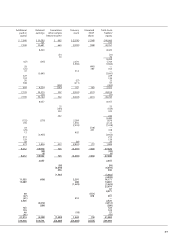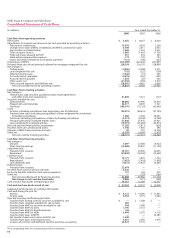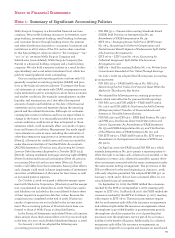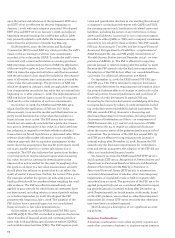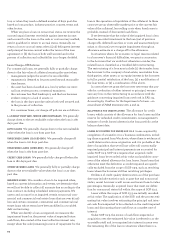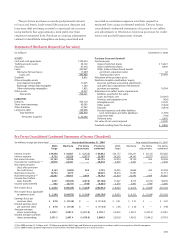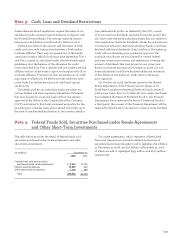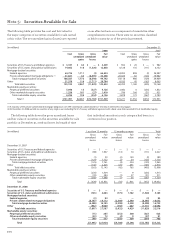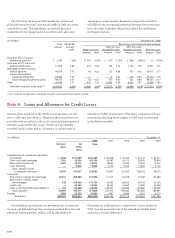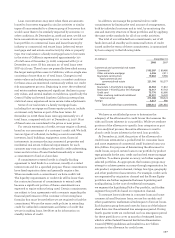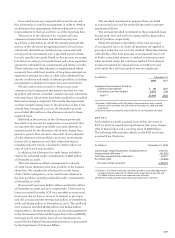Wells Fargo 2008 Annual Report Download - page 101
Download and view the complete annual report
Please find page 101 of the 2008 Wells Fargo annual report below. You can navigate through the pages in the report by either clicking on the pages listed below, or by using the keyword search tool below to find specific information within the annual report.
Interpretation No. 48, Accounting for Uncertainty in Income
Taxes – an interpretation of FASB Statement No. 109 (FIN 48),
resulting in two components of income tax expense: current
and deferred. Current income tax expense approximates
taxes to be paid or refunded for the current period and
includes income tax expense related to our uncertain tax
positions. We determine deferred income taxes using the bal-
ance sheet method. Under this method, the net deferred tax
asset or liability is based on the tax effects of the differences
between the book and tax bases of assets and liabilities, and
recognizes enacted changes in tax rates and laws in the period
in which they occur. Deferred income tax expense results
from changes in deferred tax assets and liabilities between
periods. Deferred tax assets are recognized subject to man-
agement’s judgment that realization is more likely than not.
A tax position that meets the “more likely than not” recognition
threshold is measured to determine the amount of benefit to
recognize. The tax position is measured at the largest amount
of benefit that is greater than 50% likely of being realized upon
settlement. Foreign taxes paid are generally applied as credits
to reduce federal income taxes payable. Interest and penalties
are recognized as a component of income tax expense.
Stock-Based Compensation
We have stock-based employee compensation plans as more
fully discussed in Note 19. Under FAS 123(R), Share-Based
Payment, compensation cost recognized includes (1) compen-
sation cost for share-based payments granted prior to, but not
yet vested as of January 1, 2006, based on the grant date fair
value estimated in accordance with FAS 123, and (2) compen-
sation cost for all share-based awards granted on or after
January 1, 2006. In calculating the common stock equivalents
for purposes of diluted earnings per share, we selected the
transition method provided by FASB Staff Position FAS
123(R)-3, Transition Election Related to Accounting for the Tax
Effects of Share-Based Payment Awards.
Earnings Per Common Share
We compute earnings per common share by dividing net
income (after deducting dividends on preferred stock) by the
average number of common shares outstanding during the
year. We compute diluted earnings per common share by
dividing net income (after deducting dividends and related
accretion on preferred stock) by the average number of com-
mon shares outstanding during the year, plus the effect of
common stock equivalents (for example, stock options,
restricted share rights, convertible debentures and warrants)
that are dilutive.
Derivatives and Hedging Activities
We recognize all derivatives in the balance sheet at fair
value. On the date we enter into a derivative contract, we des-
ignate the derivative as (1) a hedge of the fair value of a rec-
ognized asset or liability, including hedges of foreign curren-
cy exposure (“fair value” hedge), (2) a hedge of a forecasted
transaction or of the variability of cash flows to be received
or paid related to a recognized asset or liability (“cash flow”
hedge), or (3) held for trading, customer accommodation or
asset/liability risk management purposes, including economic
hedges not qualifying for hedge accounting under FAS 133,
Accounting for Derivative Instruments and Hedging Activities
(“free-standing derivative”). For a fair value hedge, we record
changes in the fair value of the derivative and, to the extent
that it is effective, changes in the fair value of the hedged
asset or liability attributable to the hedged risk, in current
period earnings in the same financial statement category as
the hedged item. For a cash flow hedge, we record changes in
the fair value of the derivative to the extent that it is effective
in other comprehensive income, with any ineffectiveness
recorded in current period earnings. We subsequently reclas-
sify these changes in fair value to net income in the same
period(s) that the hedged transaction affects net income in
the same financial statement category as the hedged item. For
free-standing derivatives, we report changes in the fair values
in current period noninterest income.
For fair value and cash flow hedges qualifying for hedge
accounting under FAS 133, we formally document at incep-
tion the relationship between hedging instruments and
hedged items, our risk management objective, strategy and
our evaluation of effectiveness for our hedge transactions.
This includes linking all derivatives designated as fair value
or cash flow hedges to specific assets and liabilities in the
balance sheet or to specific forecasted transactions.
Periodically, as required, we also formally assess whether the
derivative we designated in each hedging relationship is
expected to be and has been highly effective in offsetting
changes in fair values or cash flows of the hedged item using
the regression analysis method or, in limited cases, the dollar
offset method.
We discontinue hedge accounting prospectively when
(1) a derivative is no longer highly effective in offsetting
changes in the fair value or cash flows of a hedged item, (2) a
derivative expires or is sold, terminated or exercised, (3) a
derivative is de-designated as a hedge, because it is unlikely
that a forecasted transaction will occur, or (4) we determine
that designation of a derivative as a hedge is no longer
appropriate.
When we discontinue hedge accounting because a deriva-
tive no longer qualifies as an effective fair value hedge, we
continue to carry the derivative in the balance sheet at its fair
value with changes in fair value included in earnings, and no
longer adjust the previously hedged asset or liability for
changes in fair value. Previous adjustments to the hedged
item are accounted for in the same manner as other compo-
nents of the carrying amount of the asset or liability.
When we discontinue cash flow hedge accounting because
the hedging instrument is sold, terminated or no longer des-
ignated (de-designated), the amount reported in other com-
prehensive income up to the date of sale, termination or de-
designation continues to be reported in other comprehensive
income until the forecasted transaction affects earnings.
When we discontinue cash flow hedge accounting because
it is probable that a forecasted transaction will not occur, we
continue to carry the derivative in the balance sheet at its fair


